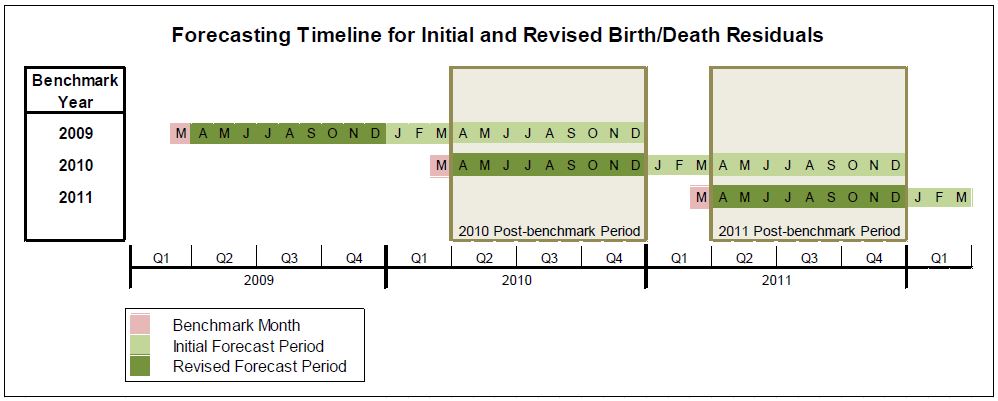An official website of the United States government
 United States Department of Labor
United States Department of Labor
Effective with the release of preliminary January 2011 employment estimates in February 2011, BLS will begin updating the Current Employment Statistics (CES) net birth-death model component of the estimation process more frequently, generating birth-death factors on a quarterly basis instead of annually. This will allow CES to incorporate Quarterly Census of Employment and Wages (QCEW) data into the birth-death model as soon as it becomes available. This more frequent updating will help to reduce what is known as the "post-benchmark revision" in the CES series. There will be no change to the timing or frequency of the current CES monthly or annual releases. Benchmarking to the QCEW will continue to be done on an annual basis. The first monthly estimates to be affected by this change will be for the reference month of April 2011.
CES estimates are benchmarked annually to March employment counts derived primarily from the QCEW, which is based on Unemployment Insurance tax records. On a not seasonally adjusted basis, the sample-based estimates for the year preceding and the 9 months following the March benchmark are subject to revision. The 9 months following the March benchmark are referred to as the post-benchmark period. These 9 months of data are revised by applying previously derived over-the-month sample changes and newly calculated net birth-death factors to the March benchmark level. The change between the original birth-death factors used for this time period and the new factors calculated as part of the benchmark process is a major component of the post-benchmark revision.
Currently, the original birth-death factors are calculated on an annual basis and then applied each month during development of monthly estimates. By switching to the more frequent quarterly computation of the factors, the size of the post-benchmark revision to the birth-death factor is expected to be smaller than under the current methodology. BLS research results shown below support this conclusion.
Using the current annual forecasting methodology, CES estimates net birth-death factors twice for the months following the associated March benchmark, that is, April-December. The initial forecasts are 13-21 months out from the QCEW input data. For example, the initial forecasts for April-December 2010 were created using input histories that ended in March 2009. Revised forecasts, created using input histories that end with March 2010, will replace the initial forecasts with the introduction of the 2010 benchmark. The change in the cumulative contribution of these net birth-death factors from the initial values to the revised values comprises the birth-death component of the post-benchmark revision.
A visual representation of the initial and revised birth-death components is presented in figure 1. As shown in the figure, revised birth-death factors for the 2010 post-benchmark period (the months April-December 2010) replace initial factors made during the prior year.
Figure 1. Timeline for Initial and Revised Birth-Death Forecasts

As shown in figure 1, under the annual net birth-death residual forecasting methodology, forecasts extend out up to 21 months beyond the latest QCEW data used in the model. QCEW data for more recent quarters that subsequently become available are not utilized for modeling until the next annual forecasts are produced.
The quarterly forecasting methodology will produce initial forecasts that extend, at most, 12 months. For example, initial quarter 1 forecasts, using input data through March 2010, would forecast net birth-death components through March 2011. When quarter 2 QCEW data is made available, initial forecasts would be made for the months April-June 2011. Similarly, forecasts for July-September 2011 and October-December 2011 would be made when new quarter 3 and 4 QCEW data, respectively, become available. Because the quarterly updating allows the most recent quarter of available QCEW data to be incorporated immediately, rather than at the end of the year, revisions between the initial birth-death factors and the revised birth-death factors are usually reduced.
Table 1 below shows a comparison of the cumulative contribution of net birth-death components to the post-benchmark employment level for the years 2003-2009 using both an annual and quarterly methodology. They show that the birth-death component revisions in the post-benchmark period would have been smaller in 5 of the last 7 years with the quarterly methodology. It is notable that the most significant reduction in the size of the revision was seen in the 2009 post-benchmark period, when earlier incorporation of quarterly data reflecting the sharp employment drop during the recession would have most influenced the birth-death factors. This suggests that the quarterly methodology should help CES estimates better reflect turning points.
| Post-benchmark Year | Forecast | Annual Methodology | Quarterly Methodology |
|---|---|---|---|
|
2009 |
Initial | 990 | 730 |
| Revised | 585 | 585 | |
| Difference | -405 | -145 | |
|
2008 |
Initial | 1005 | 1008 |
| Revised | 825 | 825 | |
| Difference | -180 | -183 | |
|
2007 |
Initial | 1059 | 1024 |
| Revised | 883 | 883 | |
| Difference | -176 | -141 | |
|
2006 |
Initial | 906 | 1115 |
| Revised | 1002 | 1002 | |
| Difference | 96 | -113 | |
|
2005 |
Initial | 866 | 846 |
| Revised | 817 | 817 | |
| Difference | -49 | -29 | |
|
2004 |
Initial | 889 | 788 |
| Revised | 827 | 827 | |
| Difference | -62 | 39 | |
|
2003 |
Initial | 768 | 740 |
| Revised | 695 | 695 | |
| Difference | -73 | -45 |
For additional information, please contact the CES Benchmark Branch at cesinfo@bls.gov or 202-691-6555.
Last Modified Date: February 14, 2020